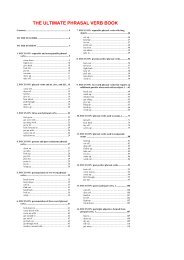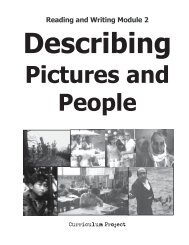Developing Speech and Language Skills - Noel's ESL eBook Library
Developing Speech and Language Skills - Noel's ESL eBook Library
Developing Speech and Language Skills - Noel's ESL eBook Library
You also want an ePaper? Increase the reach of your titles
YUMPU automatically turns print PDFs into web optimized ePapers that Google loves.
Intelligibility<strong>Speech</strong> development <strong>and</strong> speech impairmentsTom’s speech is usually intelligible, but if particular combinations of error patternscombine when he is trying to get his message across, he will need to have access to arange of strategies to make himself understood.How to help children with a phonological delay● Ways to support children with a phonological delay in school are provided inChapter 5 with information sheets provided on the CD.● They may also benefit from some of the listening activities in Chapters 7–14.Phonological disorder: unusual patterns used consistentlyChildren described as having a phonological disorder of this type can be distinguishedfrom those with delayed development by the presence of non-developmental errorpatterns. These are patterns that are not found in typical speech development. Nondevelopmentalpatterns include ‘backing’ where ‘k’, ‘g’ <strong>and</strong> ‘ng’ are used in place of ‘t’,‘d’ <strong>and</strong> ‘n’. A word like ‘teddy’ sounds like ‘keggy’. Another pattern is where childrenmiss sounds at the beginning of words or syllables so ‘key’, ‘tea’ <strong>and</strong> ‘sea’ all sound like‘ee’, <strong>and</strong> ‘copy’, ‘coffee’ <strong>and</strong> ‘toffee’ all sound like ‘o’ee’. These patterns are shown in thecartoons of Emily <strong>and</strong> Harry in Chapter 1, pages 15–17. In addition to the nondevelopmentalpatterns, they also use patterns found in typically developing children,such as those described in Tables 4.2–4.5.Many children with phonological disorders of this type have been found to haveproblems with speech perception such as distinguishing rhyming pairs of words, <strong>and</strong>storing information about the phonological system of their native language. It comes asno surprise that they often have problems with the development of phonologicalawareness <strong>and</strong> development of literacy.How common is this?About one in five children with speech impairments have phonological disorders of thistype (Broomfield <strong>and</strong> Dodd 2004a).Example of a child with a phonological disorder who uses non-developmental patternsBen, aged four <strong>and</strong> a half, is an example of a child with this type of phonologicaldisorder. Some of the patterns in his speech are those found in typically developingchildren but others are not. In the examples shown in Table 4.10 two nondevelopmentalpatterns are noted. One is where Ben uses an alveolar sound in place ofa bilabial: ‘n’ replaces ‘m’; ‘t’ replaces ‘p’; <strong>and</strong> ‘d’ replaces labiodental ‘v’. He also has anunusual pattern of cluster reduction, where he produces a bilabial consonant ‘b’ in anycluster where the following sound is a ‘w’ or ‘r’.47











